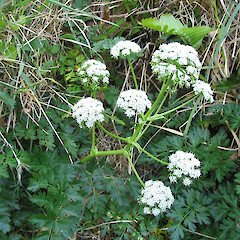Anisotome lyallii
Common name
Lyall’s carrot
Synonyms
Ligusticum lyallii Hook.f., Anisotome intermedia Hook.f., Ligusticum intermedium Hook.f., Ligusticum intermedium var. oblongifolium Kirk, Anisotome intermedia var. oblongifolium (Kirk) Cheeseman
Family
Apiaceae
Flora category
Vascular – Native
Endemic taxon
Yes
Endemic genus
No
Endemic family
No
Structural class
Herbs - Dicotyledons other than Composites
NVS code
The National Vegetation Survey (NVS) Databank is a physical archive and electronic databank containing records of over 94,000 vegetation survey plots - including data from over 19,000 permanent plots. NVS maintains a standard set of species code abbreviations that correspond to standard scientific plant names from the Ngä Tipu o Aotearoa - New Zealand Plants database.
ANILYA
Chromosome number
2n = 22
Current conservation status
The conservation status of all known New Zealand vascular plant taxa at the rank of species and below were reassessed in 2017 using the New Zealand Threat Classification System (NZTCS) – more information about this can be found on the NZTCS website. This report includes a statistical summary and brief notes on changes since 2012 and replaces all previous NZTCS lists for vascular plants.
Please note, threat classifications are often suggested by authors when publications fall between NZTCS assessment periods – an interim threat classification status has not been assessed by the NZTCS panel.
- Conservation status of New Zealand indigenous vascular plants, 2017 . 2018. Peter J. de Lange, Jeremy R. Rolfe, John W. Barkla, Shannel P. Courtney, Paul D. Champion, Leon R. Perrie, Sarah M. Beadel, Kerry A. Ford, Ilse Breitwieser, Ines Schönberger, Rowan Hindmarsh-Walls, Peter B. Heenan and Kate Ladley. Department of Conservation. Source: NZTCS and licensed by DOC for reuse under the Creative Commons Attribution 4.0 International licence.
2017 | At Risk – Relict | Qualifiers: RR
Previous conservation statuses
2012 | At Risk – Naturally Uncommon | Qualifiers: Sp
2009 | At Risk – Naturally Uncommon
2004 | Range Restricted
Distribution
Endemic. New Zealand: South Island (Fiordland coast from Jacksons Bay to Puysegur Point, Nugget Point to South Head), Stewart Island/Rakiura (common along western and southern coastline), Solander Island / Hautere.
Habitat
Coastal. On steep, south facing, sparsely vegetated cliffs, and in coastal turf, herbfield and on damp peaty ledges. Sometimes in coastal grassland, on boulder falls and even on sand dunes and beaches. In all its habitats it always found near the sea often within the spray zone.
Detailed description
Perennial herb up to 0.8 m tall. Basal leaves on petioles 10–150 × 15–100 mm; sheaths 3–130 × 15–40 mm (sheaths of cauline leaves inflated); lamina oblanceolate to oblong, 0.10–0.45 × 0.02–0.13 m, 2–3-pinnate; primary leaflets 5–10 pairs, rhomboid, deltoid to ovate, shortly petiolate, coriaceous; secondary leaflets spathulate to rhomboid, sometimes ovate; leaflet margins not thickened, often pinnatifid, rarely deeply incised into broad or narrow, toothed segments; teeth obtuse to acute, not piliferous. Inflorescence up to 0.9 m tall and 10 mm diameter at the first node; peduncles 20–150 mm long. Flowers dirty white to white. Staminate plants: involucre comprising several linear to lanceolate bracts, 4–18 × 0.5–2.5 mm; involucel of several linear bracteoles 2–10 × 0.25–1 mm; rays 10–35, 5–25 mm long; pedicels 10–30, 1–5 mm long. Carpellate plants: involucre of several linear to lanceolate bracts 5–25 × 0.5–5 mm, the bracts sometimes bearing reduced blade at the tip; involucel of several linear bracteoles 2–10 × 0.5–1.5 mm; rays 4–30, 5–30 mm long; pedicels 5–25, 1–7 mm long; styles slender, 1–2 mm long, divergent to divaricate. Mericarps narrowly elliptic to elliptic, ovate or elliptic-ovate, 4.0–7.5 mm long; apex usually slightly narrowed; base obtuse to truncate; 5-ribbed, ribs even, equal, thin, narrowly winged, opaque or translucent at margin; surface dull, ribs orange, orange-brown or dark brown, vittae visible or partially obscured, red-brown or dark brown.
Similar taxa
Most closely allied to A. acutifolia Kirk, which is a much larger, soloniferous plant with wider, coarsely toothed leaves and ligulate leaf sheaths. Anisotome acutifolia is allopatric from A. lyallii and is endemic to the Snares Islands/Tini Heke group.
Flowering
November–January
Flower colours
White
Fruiting
January–March
Propagation technique
Easily grown from fresh seed and rooted pieces. Prefers a sunny situation. It should be planted in a deep, permanently moist, peaty soil. This species does not like humidity and hot climates, and does best in a south facing or cool site, even though for it flower it needs full sun for most of the day.
Threats
Accessible populations in Fiordland and on Stewart Island/Rakiura are probably browsed by deer. It is very common on Solander Island / Hautere and occurs in reasonable numbers in the south-eastern part of the South Island. Nevertheless because this species is being browsed by deer it is probably in decline.
Etymology
anisotome: Unequal sided
lyallii: Named after David Lyall (1817-1895), 19th century Scottish naturalist and surgeon with the Royal Navy, who explored Antarctica, New Zealand, the Arctic and North America and was a lifelong friend of Sir Joseph Hooker.
Winged mericarps are dispersed by wind (Thorsen et al., 2009).
Attribution
Fact Sheet prepared for NZPCN by P.J. de Lange 14 April 2007. Description based on Dawson (1961).
References and further reading
Dawson JW. 1961. A revision of the genus Anisotome (Umbelliferae). University of California Publications in Botany 33: 1–98.
Thorsen MJ, Dickinson KJM, Seddon PJ. 2009. Seed dispersal systems in the New Zealand flora. Perspectives in Plant Ecology, Evolution and Systematics 11: 285–309. https://doi.org/10.1016/j.ppees.2009.06.001.
NZPCN Fact Sheet citation
Please cite as: de Lange, P.J. (Year at time of access): Anisotome lyallii Fact Sheet (content continuously updated). New Zealand Plant Conservation Network. https://www.nzpcn.org.nz/flora/species/anisotome-lyallii/ (Date website was queried)









